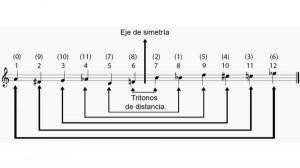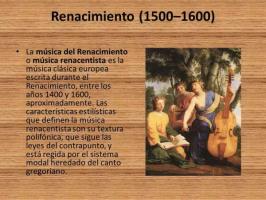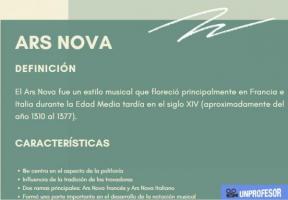ARS NOVA music: what it is and features
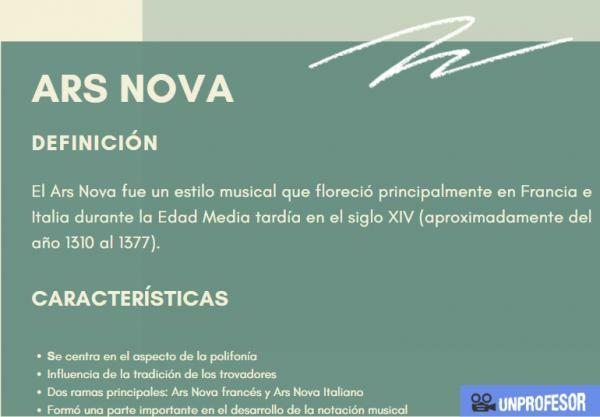
History has left us a hundred musical heritages that we can enjoy and there are in a great variety of forms, styles and motives. Some styles are well known while others are less common to mention. Even so, each musical style has left a mark on the development of music and it can be very interesting to know the origin in contrast to things as we know them today. In this lesson from a TEACHER we will talk about one of these styles: what is the Ars Nova music and features so you can learn more about this medieval style that has left its legacy in music.
Index
- What is Ars Nova music
- Characteristics of Ars Nova music
- Composers of Ars Nova
What is music Ars Nova.
The words "Ars Nova" come from Latin and mean "New art". The Ars Nova was a musical style that flourished mainly in France and Italy during the Middle Ages late in the XIV century (approximately from the year 1310 to 1377). This type of music was developed mainly in prestigious media, such as universities, stately courts, and the church.
As Ars Nova was a style subject to the academic sphere, it was in constant study and development, trying to expand the theoretical musical technical bases, notation and rhythm among other factors that would become a crucial part of the musical techniques of formal classical music.
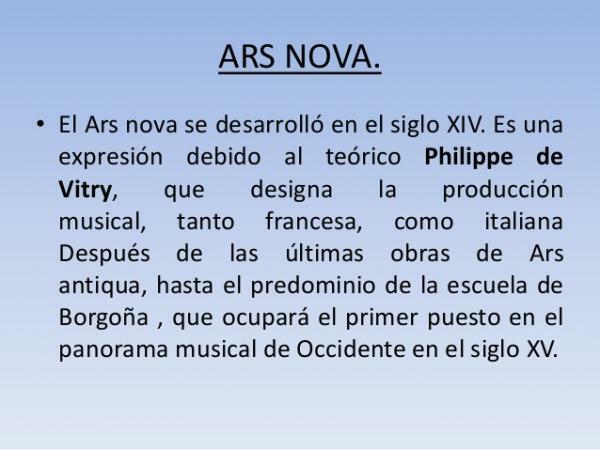
Image: Slideshare
Characteristics of Ars Nova music.
The Ars Nova Music focuses and shines in the aspect of polyphony, that is, when various voices or melodic lines sound and run musically, creating rhythmic and melodic movement.
The Ars Nova is influenced by the tradition of the troubadours, musicians of poetic forms that were dedicated to the composition of these works to interpret them themselves or to be interpreted by minstrels or minstrels in the stately courts.
It has two main branches according to the area of development: French Ars Nova and Italian Ars Nova, which is also called Trecento. The most popular musical form in the French Ars Nova style was the motet, a polyphonic vocal composition with Biblical texts ready to be performed in churches, sometimes a cappella (unaccompanied instrumental). Other forms of the Ars Nova were the rondeaux, the ballade, and the virelay. Of the Ars Nova Italiano we can say that highlights the shape of the madrigal, which is a poetic vocal musical form, with a love or pastoral theme.
He played an important part in the development of musical notation. The musical figures were diversified to be more precise. At that time the names of the figures were different from how we know them now (black, white, eighth note, sixteenth note, etc.), in contrast they had names such as semibreve, minimum and semi-minimal. This last modification in the musical writing allowed to develop therefore the rhythmic quality musical, exploring more richly the techniques of polyphony, counterpoint, syncopation and canon between others.

Image: Slideshare
Composers of Ars Nova.
Now that we know what the Ars Nova is and its characteristics, we will finish this lesson by talking about the outstanding composers. Being a highly academic style of music, the composers and developers of Ars Nova were limited. Among them we have the following:
Philippe de Vitry (1291-1361)
He is one of the main musicians of Ars Nova, if not the most influential, since he is considered the one responsible for giving the name to the style. He is also credited with developing the concept "Isorhythmia", consisting of rhythm and pitch patterns. He was a composer, music theorist and poet based in Paris. Most of his compositions were songs and motets with 3 and 4 voices.
Guillaume de Machaut (1300-1377)
French, probably the biggest exhibitor of the Ars Nova style. He was a clergyman, poet, and composer. Like Philippe de Vitry, his main forms of composition were the song and the motet, both religious and secular. His most notable work is perhaps "Messe de Nostre Dame" (Our Lady's Mass), considered the first polyphonic Mass written solely by a composer.
Gherardello da Firenze (1320-1363)
Born in Florence (Italy), he was also known as Niccolò di Francesco. One of the main musicians of the Trecento. He is recognized primarily for his compositions for mass, madrigals, and secular music in general.
Jacopo da Bologna (1340-1386)
Italian, whose madrigals are mainly known. Of his most important works, the Codex Squarcialupi, Non al suo lover of her and Fenice fu. Besides composing, he also wrote treatises on music theory.
Already with greater knowledge of this style of music, perhaps now you can appreciate the contribution that each step in history offers it to the development of art and the raison d'être of things as we know them in the present.

Image: Slideshare
If you want to read more articles similar to Music Ars Nova: what it is and features, we recommend that you enter our category of Music history.

